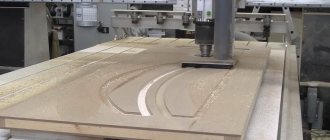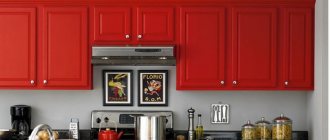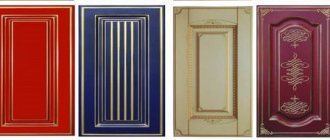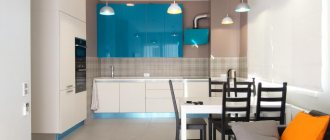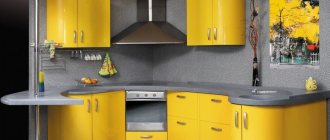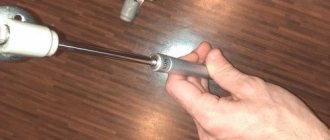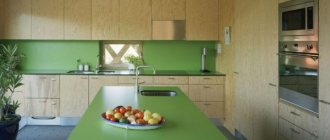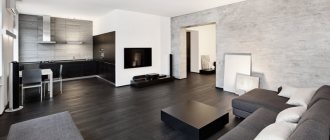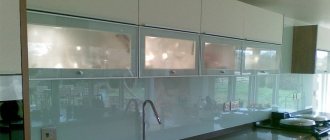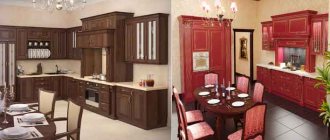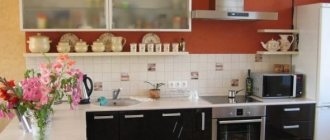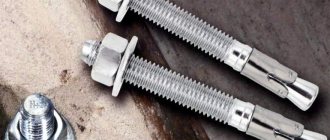Kitchen facades: what to expect from chipboard, MDF and solid wood?
There are objectively many requirements for the kitchen façade. It must be resistant to temperature changes and steam, easy to care for and, of course, attractive in appearance. Especially if you cook often or have an open plan where the kitchen is always visible. To understand the materials and understand what to expect from different facades, from traditional solid wood to modern plastic, HomeGuide turned to Elena Plotnikova, head of the Atlas Lux Krasnodar kitchen studios.
If we talk about the basis for the kitchen facade, the most economical option is laminated chipboard. New generation coatings - like TSS, for example, make it more durable and expressive enough to be used in a modern kitchen. MDF facades are more expensive, but affordable. They are more environmentally friendly than laminated chipboard and more practical than solid wood, and in addition, they have incomparably more color and texture combinations. In addition to being a 100% natural, eco-friendly material, solid wood also has a number of issues: over time, it can dry out and become deformed. Suffice it to say that factories that give more than five years of warranty on their product do not work with the array in its pure form.
Tabletop
You should take the choice of material for the countertop no less seriously. Because it is this part that takes the brunt of the blow. Therefore, it must be especially durable and maximally resistant to various influences.
The same materials can be used to make the countertop as for the body and facades.
Other suitable options:
- strained glass;
- natural and artificial stone,
- metal surface.
Glass gives a special elegance to the kitchen; you can choose different colors; it is not afraid of water and temperature. Difficulty in cleaning and low impact resistance make it less attractive.
Natural stone is beautiful and solid. They are strong and resistant to various influences, therefore they are durable. Needs constant special care. They require reliable support due to their large mass. Chips may occur.
Artificial stone is stronger than natural stone and is easy to maintain. Afraid of high temperatures and abrasive cleaning.
Stainless steel is a less attractive option for the kitchen. It has significant disadvantages: it creates noise, has an unpleasant cold surface, fades, is not scratch-resistant, and requires careful maintenance.
How to choose a kitchen façade?
- First, decide on the style: a kitchen made of solid wood or with facades made of natural veneer will fit perfectly into a classic, traditional interior; to a modern minimalist one - made of MDF with a soft touch coating (literally - “soft to the touch”), for example.
- Think about practicality: a matte kitchen, even just because of a small stain, will have to be washed entirely so that there are no streaks left. A glossy MDF facade can be simply wiped with a regular glass cleaner. At the same time, it is effective and looks expensive.
- Be sure to pay attention to the production time. In a sense, this is a litmus test that will help you understand whether you are dealing with a bona fide manufacturer or not. There cannot be less than 35, or even 45 working days - the time needed for proper drying of the panels, gluing, painting. If they offer to do everything in a week or two, most likely they are assembling the kitchen from what is lying in the warehouse. Or they dry it incorrectly.
Chipboard facades
The artificial material does not have a high density, which means it quickly fails, especially at the attachment points. In its “pure form”, without any coatings, it reacts to temperature changes and humidity. Therefore, large factories use chipboard exclusively as a basis for various finishes. You can make it stronger (and also more visually impressive) by covering it with film, acrylic or a TSS facing layer.
Pros: low cost; large selection of textures: you can reliably imitate wood, concrete, stone, eco-leather.
Cons: a chipboard façade requires an edge, which, firstly, simplifies the appearance of the product, and secondly, may peel off over time. You cannot install mortise handles in chipboard (standard board thickness is 16 or 18 mm). In its “pure form” it is inferior to all materials in terms of environmental friendliness and wear resistance. A chipboard facade cannot be radius.
- Film facades made of chipboard
They can be matte or glossy, with or without a pattern. But outwardly they are not very impressive. Glossy PVC film is always a little rough, shagreen - and does not give an ideal shine. But such a facade is the most budget-friendly. Yes, it will have an edge and only overhead fittings (no figured mortise handles), but if you need to save money, this is the best option.
- Acrylic facades made of chipboard
Acrylic is a transparent coating that is applied to a film or already painted facade. Its cost, of course, is higher than with just PVC film, but it is also noticeably stronger. Although it is vulnerable to severe damage - the impact will leave a chip on the top layer. Not being restored.
- Chipboard facades with TSS coating
TSS (Thermal Textured Surface) is essentially compressed kraft paper that is sealed under high pressure into a chipboard base. Reliably conveys the texture of different bases: natural wood, leather, concrete.
TSS coating makes even chipboard facades durable, resistant to damage and easy to maintain. In addition, such finishing will not be expensive. The only negative is the edge at the end.
MDF facades
MDF is a medium density board, pressed from small dry chips. The best option for kitchen facades: with high-quality assembly and proper care, they will safely last 10-15 years. Unlike chipboard, MDF does not have an edge and radius (bent) facades can be made from it.
MDF facades are painted, veneered, and laminated with PVC film. You can create a glossy, matte or pearlescent surface in the color or shade you need, to imitate wood, concrete or metal. And use not only overhead, but also mortise fittings.
Pros: surface without joints up to 2.7 meters, thickness from 3 to 60 mm. Strong and durable material, can be restored.
Cons: artificial material.
- Film facades from MDF
PVC film is the most budget-friendly option for finishing MDF: it costs on average 20% less than painted facades. This is a huge selection of textures and colors, easy to care for. However, the film can peel off and become deformed due to high (from 70 ℃) temperatures - it cannot be restored.
- Acrylic facades from MDF
“Kitchens made of MDF” – what is it?
In fact, “MDF kitchens” is not an entirely correct term. There are no MDF kitchens as such; there are kitchens with chipboard cabinets and MDF facades. So it would be more correct to say “kitchens with MDF facades”.
The abbreviation MDF itself is translated from English as “medium density fiberboard,” but simply decoding the term does not become clearer.
Let's go in order.
Kitchen with MDF facades painted with enamel.
As we have already said, the facades are made of MDF. But the MDF board itself is not very beautiful.
MDF board without treatment.
There are several ways to make such a facade attractive:
- Paint with enamel
- Cover with film
- Cover with plastic.
We have already talked about plastic facades in our blog here and here, painting with enamel will be the central topic of one of the upcoming articles, and today let's focus on facades made of MDF coated with PVC film.
MDF facades: a look from the inside
To better understand the pros and cons of facades covered with PVC film, let's understand a little about how they are made. First of all, milling is applied to the MDF board. There are many standard options for milling patterns; they can be combined at the request of the customer. The variety of milling methods is one of the big advantages of MDF facades, because an unusual pattern will make even a façade of the most banal color original.
General finishing features
The technology for making a kitchen from both materials is basically similar. The basis of the first type of furniture is MDF (medium-density fiberboard), covered with PVC film or painted with enamel. The design of the second type of furniture includes chipboard or MDF boards with overlays applied to them, for the manufacture of which plastic is used. In both cases, the frame is first made, and then only the kitchen facades are finished.
Each material is durable, easy to care for, environmentally friendly, and not subject to destruction by ultraviolet radiation. Both options have an affordable price, a huge variety of design solutions and colors, which is not typical for expensive and prestigious solid wood furniture.
Advice! When purchasing a kitchen set, you need to pay attention to the thickness of the facades: for chipboard it should be at least 18 mm, and for painted or film-coated MDF it should be 16 mm.
Kitchen design with MDF facades
One of the main design advantages of film facades is the variety of color palettes.
Film-coated facades can be matte or glossy. Glossy facades are more suitable for kitchens in the “modern” style, while matte ones are used in kitchens of any style.
Kitchen with textured fronts.
Kitchen with glossy film facades.
Classic kitchen with MDF facades.
Another way to make MDF facades beautiful and original is patination. Patination gives the film-coated façade an antique effect. This effect looks especially good on facades with a film that imitates wood.
Kitchen “Elegy” with patinated facades.
Patination can also be used to highlight milling. The resulting accent makes the facades more textured.
Facades with silver patina in a classic kitchen.
The patina itself can be dark, silver or golden.
A variant of a classic kitchen in the Italian style with facades with a gold patina.
Compare the advantages and disadvantages of facades
To evaluate the capabilities of different types of facades, we suggest that you familiarize yourself with their advantages and disadvantages according to a number of criteria.
| Criteria | Plastic facades | Acrylic facades | Enamel facades |
| Price | The cheapest option, but less reliable and durable | Acrylic is more expensive and more wear-resistant than regular plastic | Quite a high manufacturing cost, resulting in a high final cost of the headset |
| Kinds | The facade can be matte or glossy | The facade can be matte or glossy | The facade can be matte or glossy, there are other options: high gloss, abrasive; additional special effects: pearls, mother-of-pearl, metallic, chameleon, etc. |
| Configuration | Can be deaf and in an aluminum frame | Can be deaf and in an aluminum frame | varied in configuration: solid, showcase, aluminum frame |
| Styles | Modern | Modern | Classic and modern |
| Color, pattern | It mainly imitates wood, so both color and pattern in this material are limited | Richer color palette and design options, 3D drawing is possible | The largest variety - about 700 shades |
| Decor | Decor is not applied | Photo printing can serve as decor | Milling and patina are possible only in such kitchens |
| Heat resistance | It may be damaged near an oven or stove. | The most heat-resistant, does not burn, but melts at a temperature of 160 degrees | Tolerates exposure to high temperatures well. There are no traces of hot liquid, no pans left |
| Moisture resistance | Average moisture resistance | High moisture resistance | Average moisture resistance |
| Burnability | Has UV protection | Most resistant to color fading | Paint can fade in the sun and under the influence of ultraviolet radiation |
| Scratches, cracks | Good resistance to mechanical stress, high humidity, and aggressive substances | Most resistant to damage; if a defect does appear, it is eliminated using special grinding | Cracks and chips may appear from impacts, but the surface is easy to restore |
| Care | Do not use abrasive or chemically aggressive products. The best option is a soft cloth and soap solution. | There are special products and polish | The facades do not require complex care; just wash them with water and a mild detergent |
| Eco-friendliness | Does not release harmful substances into the air | Environmentally friendly material, recyclable | When exposed to temperature, no substances harmful to human health are released into the atmosphere |
| Radius facades | Only straight facades | If an acrylic panel is used, the facades can only be straight. If the film is acrylic, it is possible to make radius | It is possible to make facades of any complex shapes |
On the “Kitchen Biograph” website you can order a kitchen made of plastic, enamel or acrylic in the sizes you need, or buy a ready-made one at the exhibition center, which is located in Lyubertsy at the address: st. Initiative, 50, office 1.
| Plastic kitchen | Acrylic kitchen | Enamel kitchen |
Conflicting reviews...what to believe?
Due to their availability and variety of products, MDF facades have become very popular. It is not surprising that there are conflicting reviews about them. What can I say, we ourselves at Mebel.Pro chose partner suppliers of film facades for several years until we settled on two factories that were able to provide decent quality at an affordable price.
The fact is that due to the popularity of such facades, some unscrupulous manufacturers, in pursuit of low cost, begin to save unnecessarily. They use insufficiently high-quality film, use poor glue, work on outdated and worn-out machines, and hire unqualified personnel.
At first, a low-quality facade is no different from a high-quality one, but it will not last long. The most common complaints about poor-quality facades are the following:
- The film fades in the sun,
- The film peels off, especially on facades located near the hob,
- The film is easily damaged when cleaning.
All these complaints are typical specifically for low-quality film facades.
Good quality facades will serve you for many years without complaints.
There are now many manufacturers of MDF facades, and only the customer can decide whether it is worth the risk and saving.
Advantages of plastic
Unlike MDF and laminated chipboard, plastic is not the basis for the manufacture of kitchen furniture, but its decorative coating. This is the best way to preserve the appearance of the facade. Thanks to this additional coating, kitchen furniture will last much longer and retain its appearance. Caring for a plastic surface does not present any difficulties: it can be easily cleaned with detergents without absorbing them, and is easily wiped off from dirt.
Since plastic is only a coating, a base is used to make the kitchen facade. Such a basis can be a budget option - chipboard or a more expensive one - MDF. During processing of the base material, plastic is glued to its surface.
The plastic is based on ordinary paper, which allows you to combine different colors, designs, and create a unique product for further use. Color design will favorably emphasize the appearance of kitchen furniture and make it more visually attractive.
- durable to use;
- heat resistant;
- moisture-resistant material;
- large selection of colors and patterns;
- easy to clean, does not absorb heavy dirt;
- does not fade in the sun.
Thus, plastic will become the best material for additional coating. It is perfect for a long period of use and will be well preserved. Cleaning kitchen surfaces will become even easier, since the plastic is easy to wipe off and does not come into contact with detergents.
Kitchens made of MDF: plastic options, films, enameled in kitchen design
Today there are many materials for making kitchen furniture. While solid wood, being one of the highest quality types of material, is not available to everyone, most buyers prefer furniture based on particle boards.
90% of all furniture industry products are based on MDF boards, made from fine wood chips made from polymer resins that are pressed together under high temperature and pressure.
MDF boards are much cheaper than wood, but are practically not inferior to it in strength, reliability and wear resistance. Different models of kitchen furniture have different designs, but most of them are based on durable MDF.
Pros and cons of laminated chipboard body material
The advantages of chipboard are as follows:
- fairly inexpensive in cost;
- covered with many types of laminate;
- endurance to the influence of high temperature;
- it is very easy to process in the manufacture of cabinet furniture.
The disadvantages include:
- strong looseness of matter;
- poor retention of screws, especially when reused;
- nails are practically not held inside the slab;
- service life is no more than 10 years.
In the manufacture of this building material, the shavings may contain substances that emit formaldehyde in moderate quantities. They are quite harmful to humans.
This modern material is produced in large factories from wood shavings. It is ground and mixed with resin. Subsequently sawn into slabs.
What types of MDF-based kitchens are there?
The main difference between the models is the outer MDF covering, which can be made of:
- applied coating - paint or enamel;
- plastic and acrylic;
- polymer film.
There are also kitchens made of laminated and framed MDF, which are also in demand on the market. Which furniture is best for the kitchen depends on each specific case.
Depending on the buyer’s financial capabilities, as well as the features and mode of operation of the kitchen, you can choose any of the options. Each of them has its own advantages and disadvantages, price category and care features.
Kitchen made of painted MDF
Painted MDF is one of the popular options among buyers. The main advantage of this type of material for making facades of kitchen units is a wide color palette in accordance with RAL, thanks to which you can choose almost any shade of facades according to the design idea.
Ease of care is another advantage of painted MFD, which is easy to clean and does not absorb dirt and foreign odors.
The disadvantages of enameled MDF include its rather high cost compared to kitchens made of plastic or acrylic. The paint that coats particle boards tends to fade over time, losing its presentable appearance.
Vulnerability to damage, as well as high visibility of fingerprints, can also be considered disadvantages of enameled MDF.
MDF facades with PVC film
Facades finished with film imitating various wood textures are a fairly popular furniture option for kitchens in the low price segment. Low cost is perhaps the only advantage of such kitchens.
At the same time, the film gives kitchen units a rather old-fashioned and cheap appearance, because... has no texture. Most often, such kitchens are chosen for temporary residence on site, for renting out an apartment and other conditions when an expensive option is not required.
Facades with PVC film can be safely washed using aggressive household chemicals, but you need to be careful when installing cabinets in an area with high humidity and heat generation. Above the stove and sink, the film peels off very quickly, making the furniture unpresentable.
Over time, the film coating of MDF facades may darken, which is also not an advantage of such furniture.
Features of plastic headsets
This material is popular due to both its technical characteristics and aesthetic qualities:
- Moisture resistance makes it possible to clean with any detergent;
Attention! Glossy plastic is not recommended to be cleaned with abrasive substances - they scratch the surface.
- Reliability; Wear resistance; Service life is 20-25 years; Plastic is resistant to temperature changes; A wide range of textures, patterns, colors, imitations of various materials.
When used for kitchen furniture, plastic has some disadvantages, for example, the possibility of geometric defects when manufactured by cold pressing. The white color of the back side contributes to a fairly rapid deterioration in the appearance of this part of the facade. Matte plastic is difficult to wash, as a result of which it gradually loses its aesthetic properties. Glossy surfaces resist fingerprints better.
Kitchens with plastic facades
When we say “kitchens made of plastic”, in our minds they are completely made of plastic. But this idea is incorrect: in fact, plastic facades are also based on MDF, which is covered with plastic on top using a special glue. The color of the plastic can be any, and the texture can be glossy or matte.
The advantages of this type of MDF facades are durability, resistance to cleaning agents and detergents, moisture resistance and resistance to ultraviolet radiation.
Just like enameled MDF, fingerprints remain on plastic facades, which is one of the main problems in the operation of kitchen furniture. Plastic is more difficult to wash, which is also considered one of the disadvantages of this material.
Typically, a kitchen made of plastic is decorated in a modern design style, without unnecessary details and decorative elements. The manufacturer focuses on color and texture, providing the buyer with a very wide palette of color solutions.
Advantages of laminated chipboard
Chipboard - chipboard, replaced facades made of ordinary wood. This material has become a budget option for making kitchen furniture.
The basis of the material is dried shavings, pressed together with synthetic resins. For a better appearance, the chipboard is varnished, and the surface is covered with additional material that hides the unevenness remaining after sanding.
Laminated chipboard is the cheapest option for making a facade. But, unfortunately, of poor quality. A kitchen facade made of this material will look cheap and unattractive. Laminated chipboard cannot be adjusted to the desired shape, since it is not flexible. Only simple designs can be made from it, which can hardly be called fashionable and easy to use.
- very cheap material;
- can be used as a temporary option.
- low quality;
- must be covered with additional material;
- simple and unattractive appearance;
- low heat and moisture resistance;
- requires constant care.
The main positive quality of laminated chipboard is its low cost. This material may not be the best option for making fashionable kitchen furniture. Moreover, it does not meet all standards of kitchen equipment. But LDPS will be an ideal temporary option for a kitchen facade or a new addition to a rented apartment.
Kitchens with MDF frame fronts
Frame MDF facades are a textured surface, along the perimeter of which MDF baguettes are glued.
Such facades vaguely resemble picture frames, making them look very presentable, gravitating towards the classical style. At the same time, this is a budget material that almost everyone can afford.
Frame facades are lighter in weight compared to conventional solid or enameled MDF, but in appearance they are very close to natural wood.
The disadvantage of frame facades is their vulnerability to moisture and high temperatures, and with average quality workmanship, the seam connection of the profile can be visible, which somewhat spoils the appearance of the furniture.
How to choose the right facade material
It is impossible to say in absentia which is better for your kitchen - MDF or plastic. Depending on the goals you pursue in choosing a kitchen unit, as well as the design and general orientation of the interior of your living space, you can choose one option or another.
Furniture made from enameled MDF, due to its higher cost, will fit well into an interior made in a classic style, being visually very similar to natural wood.
If you want to choose a more affordable option for the kitchen, then plastic or film will suit you. Depending on the overall design concept, choose an inexpensive film that can imitate various textures, but if you want to create a more harmonious and expensive-looking kitchen design, choose kitchen plastic or laminated, enameled or painted MDF.
Plastic kitchens look great in a modern design, and you have a very large selection of kitchen set models to suit every taste.
The glossy shine combined with the bright color of the plastic makes a spectacular impression. If desired, you can opt for colorful and discreet neutrals (black, gray, white, brown, beige and milky). If you want a quieter kitchen interior, choose matte plastic.
If you are faced with a choice - film or plastic - always choose the latter option, even if it costs more. If you are interested in a long service life, it is better not to chase cheap options
But if you plan to rent out an apartment with the risk that tenants will damage the furniture (this often happens), then kitchens with a film coating are completely worth it.
Which cuisine is better? If the choice is plastic or MDF for your own kitchen, then MDF has a longer service life, which will serve you faithfully with proper care. Although when choosing enamel or plastic, there are also supporters of the latter: high-quality plastic with an additional protective coating also shows itself well in terms of durability.
When choosing material for execution, always focus on the following parameters:
- how often do you need to wash your furniture;
- whether constant exposure to moisture and high temperature is expected;
- how often do you want to renovate and update your kitchen design?
What material is better to use?
The answer to this question depends on several factors.
Firstly, the price characteristic. If kitchen furniture should become a regular budget option, you should use laminated chipboard. MDF is a much better option, but accordingly it costs more. It resembles natural wood and is of higher quality.
Secondly, surface treatment. Chipboard is initially treated with varnish, but the coating must be finished with plastic. With the help of finishing material, the top ball of the kitchen facade will become smooth and suitable for use. The surface of MDF can be treated with enamel or PVC film. This will improve the appearance of the facade and make it smoother. In order to extend the life of the facade, it is better to treat it with additional material – plastic.
Thirdly, the shelf life. If kitchen furniture is made for a long period, you should spare no expense and choose MDF. Laminated chipboard is perfect only as a temporary option.
Fourthly, design. If you plan to make kitchen furniture in a fashionable style with round corners and additional design options, MDF will be the only option.
Finding the right material for making kitchen furniture is very difficult. It all depends on the price characteristics, duration of operation, appearance and design. The market offers a wide selection of raw materials for kitchen facades, but the best option is plastic-coated MDF. It includes all the necessary qualities to produce perfect kitchen furniture.
